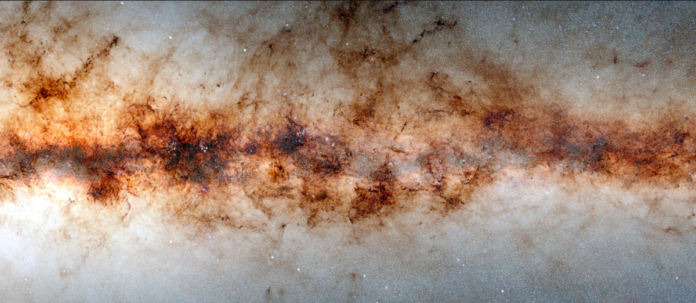An ambitious new survey of the Milky Way’s galactic plane has revealed 3.32 billion cosmic objects in stunning detail.
The enormous celestial catalog, possibly the largest of its type, was built using data from the Dark Energy Camera at the Cerro Tololo Inter-American Observatory in Chile, which is operated by the U.S. National Science Foundation (NSF).
“Imagine a group photo of over three billion people and every single individual is recognizable!” Debra Fischer, division director of Astronomical Sciences at the NSF, said in a statement (opens in new tab). “Astronomers will be poring over this detailed portrait of more than three billion stars in the Milky Way for decades to come.”
Related: See amazing photos from the Dark Energy Camera in Chile
Our Milky Way galaxy is populated by hundreds of billions of stars, huge numbers of star-birthing regions and massive clouds of gas and dust. Cataloging such objects is a massive task, but the team behind the new catalog — the second data release from the Dark Energy Camera Plane Survey, known as DECaPS2 — was up to the challenge.
The researchers used the Dark Energy Camera to observe the plane of the Milky Way at optical and near-infrared wavelengths, revealing this region of our galaxy in unprecedented detail. The catalog took two years to complete, with the Dark Energy Camera producing over 10 terabytes of data from 21,400 individual exposures of the southern sky, team members said.
“One of the main reasons for the success of DECaPS2 is that we simply pointed at a region with an extraordinarily high density of stars and were careful about identifying sources that appear nearly on top of each other,” Andrew Saydjari, lead author of a study announcing the new results, said in the same statement, which was released by the NSF on Wednesday (Jan. 18).
“Doing so allowed us to produce the largest such catalog ever from a single camera, in terms of the number of objects observed,” said Saydjari, who’s a graduate student at Harvard University and a researcher at the Harvard-Smithsonian Center for Astrophysics.
The majority of the stars and dust in the Milky Way are located in the galactic plane, which is seen as a bright band across the center of the newly released Dark Energy Camera images. While this preponderance of stars and glowing dust makes for spectacular photos, it can also make the galactic plane challenging to observe.
The dark tendrils of gas and dust that can be seen in these images absorb starlight and obscure faint stars altogether, while light from dense and cool star-birthing nebulas hinders attempts to measure the brightness of individual objects. In addition, the vast stellar population means that stars overlap in images of our galaxy’s galactic plane, making it difficult to distinguish individual stars from their neighbors.
These challenges, though significant, can be combated by looking at the galactic plane in near-infrared light. Because gas clouds don’t absorb light as well at these wavelengths, astronomers can peer through gas and dust to see stars they usually obscure.
Saydjari and the team at the Cerro Tololo Inter-American Observatory also used an innovative way of processing data that allowed them to predict the background behind each star. This method assisted them in reducing the obscuring effects of nebulas and dense stellar populations on the images, ensuring accurate processed data in the DECaPS2 catalog.
The Dark Energy Camera data was then further enhanced by integrating it with observations from other telescopes.
“When combined with images from Pan-STARRS 1, DECaPS2 completes a 360-degree panoramic view of the Milky Way’s disk and additionally reaches much fainter stars,” study co-author Edward Schlafly, who’s based at the Space Telescope Science Institute in Baltimore, said in the statement. “With this new survey, we can map the three-dimensional structure of the Milky Way’s stars and dust in unprecedented detail.”
The dataset that forms the foundation of the catalog of around 3.32 billion objects is accessible to both astronomers and the general public (opens in new tab). This new release brings the survey’s coverage of the night sky up to 6.5% and stretches for 130 degrees, equal to about 13,000 times the angular size of the full moon.
The team’s research is detailed in a paper posted on the online repository ArXiv (opens in new tab) and has been accepted for publication in the Astrophysical Journal Supplement.
The first dataset from the Dark Energy Camera Plane Survey (DECaPS) was released in 2017.
Follow us on Twitter @Spacedotcom (opens in new tab) and on Facebook (opens in new tab).

